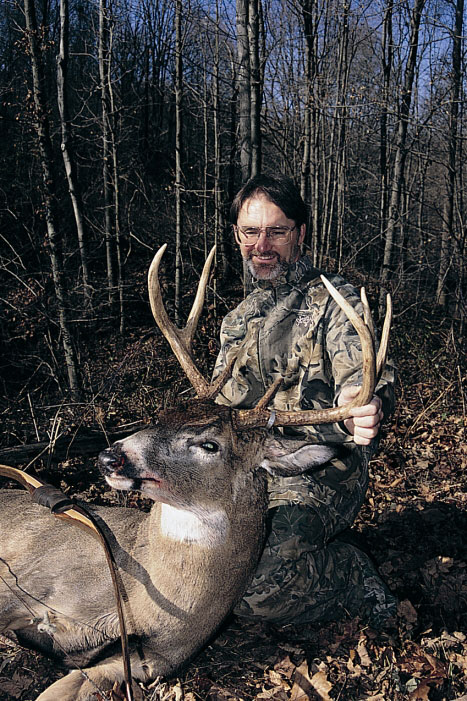 Ohioan Mike Beatty called in a 39-point non-typical whitetail using a combination of doe bleats, buck grunts, and rattling. And, perhaps more important, he somehow managed to keep his wits about him and execute a telling bowshot that was heard ’round the deer hunting world. Commonly known as The Beatty Buck, it officially scored 304 6⁄8 Boone & Crockett non-typical, and is the largest recorded whitetail ever taken by a bowhunter—or any hunter.
Ohioan Mike Beatty called in a 39-point non-typical whitetail using a combination of doe bleats, buck grunts, and rattling. And, perhaps more important, he somehow managed to keep his wits about him and execute a telling bowshot that was heard ’round the deer hunting world. Commonly known as The Beatty Buck, it officially scored 304 6⁄8 Boone & Crockett non-typical, and is the largest recorded whitetail ever taken by a bowhunter—or any hunter.
Though the size of Beatty’s buck is unusual, his success with calling is not. Timely calling has often proven to be the deciding factor between not seeing deer and tagging the trophy of a lifetime. With a multitude of calls available to provide a wide range of deer vocalizations, many hunters wonder which calls they need, as well as when and where to use them to reap the greatest advantage.
“It really isn’t complicated,” says Ed Sceery of Sceery Game Calls, who holds a Ph.D. in animal science. “Deer don’t have a wide vocabulary. All they can convey with their voices is mood or emotion. Calm deer make soft, quiet vocalizations. Excited deer make more intense calls.”
Whitetail and mule deer utterances range from fawn bleats to deep buck grunts, and from intermittent calls to sounds made in rapid succession. Then, there’s the buck snort-wheeze, which can be a real attention-getter when used at the right time.
Deer Vocalizations
Plaintive fawn bleats and bawls work best early in the season, before the rut. They arouse strong maternal instincts in does and are especially effective when you wish to cull does away from the herd. Bucks occasionally respond to fawn bleats out of curiosity, but it is during the secondary rut when this type of call really pays off, says Missouri’s Brad Harris, who has tagged a number of trophy whitetails.
“The secondary rut takes place about 30 days after the primary rut and can range from practically nonexistent to aggressive,” says Harris. “When bucks are active, I switch to fawn bleats combined with buck grunts because the secondary rut is often centered around young does.”
The doe bleat works throughout the season. Early on, it is a social sound that can draw bucks and does to an outsider. As the rut draws near, a doe bleat is music to a buck’s ears. And when does are coming into estrus, doe bleats are a seductive “Come hither, my good man!”
Doe bleats don’t stir the competitive juices in bucks as acutely as buck grunts, instead attracting a comparatively relaxed buck. Then again, you may need to combine doe bleats and buck grunts to convince the buck o’ the woods that he’s missing out on something good.
Buck grunts excel during the pre-rut and rut phases when bucks are preoccupied with anything associated with breeding. To get a buck’s attention, David Hale of Knight & Hale Game Calls makes individual, loud, short-burst buck grunts about 10 seconds apart. He also relies on creating the hyperventilating sound made by an excited, tending buck when it moves right up behind a doe to see if she’s ready to breed.
“That’s the most important call of all,” relates Hale. “I’ll make 15 to 20 grunts over a span of 10 seconds or so with a call that grunts when you inhale and exhale on the same end of it.”
The snort-wheeze call can also bring bucks on the run. Hale claims it works best during the rut and when hunting thick areas.
“There are two kinds of snort-wheezes,” says Hale. “One is an aggressive sound intended to ward other bucks away from the doe the buck is tending. A buck also makes a less aggressive snort-wheeze when he’s clearing his nostrils. Either sound attracts bucks, because they recognize breeding is going on.”
Next: Calling Blind, Sight Calling






